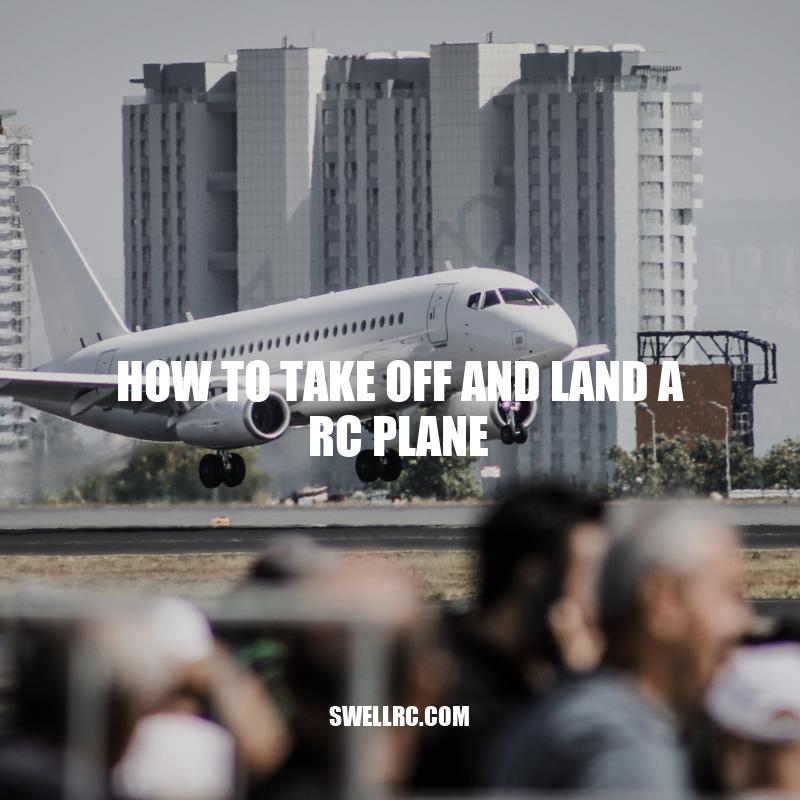How to Take Off and Land an RC Plane: A Beginner’s Guide
Remote controlled or RC planes are miniature, model airplanes that can be controlled from a distance using a hand-held transmitter. They are often popular among hobbyists and aviation enthusiasts as they allow people to experience the thrill of flying a plane without actually having to leave the ground. Taking off and landing an RC plane can be challenging for beginners, but with the right knowledge and practice, it can be an enjoyable experience. In this article, we will discuss the steps needed to take off and land an RC plane successfully, as well as some common mistakes to avoid. By the end of this guide, you will have the tools you need to start your RC plane flying journey. So, whether you are just starting out or looking to improve your skills, keep reading and learn how to take off and land an RC plane like a pro.
Pre-flight preparation
One of the most important steps in flying an RC plane is pre-flight preparation. This step ensures that your plane is ready to fly and that you have taken all necessary precautions to avoid accidents. Below are some factors to consider when preparing your RC plane for takeoff:
- Check the weather: Before flying your RC plane, check the weather conditions. Avoid high winds or rain as it can affect the plane’s stability and control.
- Check the runway: Make sure that the runway is clear of obstacles or debris that can damage the plane or cause an accident.
- Ensure batteries are charged: Check that your RC plane’s batteries are charged and ready to use. Make sure they are the correct voltage required for your RC plane.
- Calibrate your transmitter: Check that your transmitter is calibrated according to the manufacturer’s instructions. This guarantees that your commands are accurately transmitted to your RC plane.
- Check all parts: Inspect all parts of the RC plane for damage or defects, including the wings, tail, motor, and propeller. Ensure that all parts are in good condition and working properly.
Taking the time to properly prepare your RC plane before flying ensures that you can have a smooth and safe flight. Check with your local hobby shop or online hobby stores like HorizonHobby.com or TowerHobbies.com for more information and resources on pre-flight preparation.
Can you fly RC planes?
Yes, anyone can learn to fly RC planes with proper training and practice. Here are a few tips to get started:
- Choose a beginner-friendly RC plane with a stabilizer system
- Find a large, open space to fly in that’s away from buildings and people
- Connect with a local RC flying club for training and advice
- Consider using a flight simulator to practice flying before taking your plane out in the field
If you’re interested in purchasing an RC plane, consider checking out websites such as Horizon Hobby or Tower Hobbies for a variety of options and accessories.
Taking off
Taking off an RC plane requires a combination of throttle, steering and elevating controls. Below are the steps to successfully take off an RC plane:
| Steps | How to Execute |
|---|---|
| Step 1: | Set the plane on the runway. |
| Step 2: | Slowly increase throttle using the right stick of the transmitter. |
| Step 3: | Steer the plane straight down the runway using the rudder. |
| Step 4: | Pull back the elevator when the plane has enough speed to lift off. |
| Step 5: | Once in the air, use the right stick to maintain level flight and direction. |
Interesting fact: Did you know that the maximum range of control for an RC plane can reach up to two miles?
For more detailed instructions and pictures of taking off an RC plane, check out FlyingRC.net or RCGroups.com. Remember to always practice safety precautions when flying your RC plane.
How do you fly an RC plane for the first time?
Here are some basic steps to follow when flying an RC plane for the first time:
- Find an open area with no people, trees or buildings nearby.
- Check the weather conditions and make sure it’s not too windy or rainy.
- Read the instruction manual and understand the controls of your RC plane.
- Start with low speed and altitude, and practice turning left and right.
- Gradually increase the speed and altitude, and practice taking off and landing.
- Keep a safe distance from the plane and use visual cues to maintain orientation.
- Make sure to recharge or replace batteries before takeoff.
For more detailed tips and tricks, you can visit websites such as RCGroups.com or RCUniverse.com, or check out products like the RealFlight Flight Simulator that allows you to practice flying RC planes virtually.
Flying the plane
Once the RC plane is in the air, it’s time to fly! Here’s what you need to know:
Using the controls
There are two sticks on the transmitter, one on the left and one on the right. The left stick controls the throttle and speed, while the right stick controls the plane’s direction and altitude.
Basic maneuvers
Here are some basic maneuvers you can perform with your RC plane:
- Roll: Use the right stick to bank the plane left or right.
- Loop: Pull back on the right stick to climb, then use the left stick to decrease throttle and complete the loop.
- Immelmann turn: Perform a half loop, then use the right stick to turn the plane 180 degrees.
Flying tips
Here are some tips to keep in mind while flying your RC plane:
- Keep the plane level and maintain a steady speed.
- Don’t make sudden jerky movements with the controls.
- Use small adjustments to steer the plane.
Product recommendation: If you’re a beginner, a trainer plane like the HobbyZone Sport Cub S2 is a good choice. It comes with SAFE (Sensor Assisted Flight Envelope) technology, which provides stability and prevents crashes. Check out HorizonHobby.com for more details.
How to do 3D RC plane maneuvers?
To do 3D RC plane maneuvers, you need to have good control over your plane and knowledge of the necessary maneuvers. Here are some tips to get started:
- Practice hovering your plane in mid-air by adjusting your throttle and elevator controls.
- Try performing rolls by moving your ailerons left or right. Make sure you don’t lose altitude during the roll.
- Perform loops by gaining altitude and then pulling back on the elevator control while moving the ailerons to maintain balance.
- Attempt knife-edge flights by tilting your plane to one side and then adjusting your ailerons and rudder to maintain balance.
- Practice inverted flights by flipping your plane upside down and adjusting your controls to maintain altitude.
If you want to learn more about 3D RC plane maneuvers, some websites such as RC Groups and Flite Test offer helpful resources and tutorials for RC enthusiasts. You can also check out products such as the E-flite UMX Aero Commander or the Blade Inductrix Switch Air, which are designed for 3D maneuvers.
Landing
Landing an RC plane requires practice and patience. Here’s what you need to know:
Reducing throttle
As the plane approaches the runway, reduce the throttle slowly. This will bring the plane down to a slower speed.
Pulling back the elevator
Use the elevator to slow down the plane. Pull back on the right stick gently to increase drag and gradually drop altitude.
Steering the plane down the runway
Use the rudder to steer the plane down the runway. Keep the plane level and straight, and use small adjustments to keep it on course.
Common mistakes to avoid
Here are some common mistakes that beginner pilots make while landing:
- Coming in too fast and overshooting the runway.
- Not reducing throttle enough, causing the plane to bounce on landing.
- Over-correction with the rudder or elevator, causing the plane to veer off course.
Product recommendation: The RealFlight RC Flight Simulator is a great tool for practicing RC plane landings without the risk of crashing your own plane. The simulator comes with several scenarios to choose from and lets you customize scenarios for specific conditions. Check it out on Amazon.com.
Are RC planes hard to land?
RC planes can be difficult to land for beginners, but with practice and proper technique, landing can become easier. Here are some factors that can affect the ease of landing:
- Wind conditions
- Pilot’s skill level
- The size and weight of the aircraft
- The landing gear and its condition
It is important to approach the landing with the correct speed and altitude and to flare the plane just before touching down. Additionally, landing a plane with a buddy or using landing aids can make the process easier for beginners. If you are a novice and want to learn more about flying RC planes, there are many online resources available such as websites like RC Groups or products like “The Beginner’s Guide to Flying RC Airplanes” on Amazon.
Common Mistakes
Beginner pilots often make mistakes when taking off and landing an RC plane. Some common mistakes to avoid include:
Over-controlling the plane
Many beginner pilots make the mistake of over-controlling the plane, which can cause it to become unstable and crash. To avoid this, make sure to use gentle and precise movements with the control sticks.
Not keeping the plane level
Keeping the plane level is crucial for a successful takeoff and landing. Use the elevator to adjust the plane’s pitch and the ailerons to adjust its roll. Try to keep the plane level and smooth during flight.
Not adjusting speed and altitude
Another common mistake is not adjusting the speed and altitude of the plane correctly. This can cause the plane to stall or veer off course. Practice adjusting the throttle and elevator to maintain a stable flight.
Product recommendation: The E-Flite Apprentice S 15e RTF is a great choice for beginner pilots. It comes with everything you need to get started, including a transmitter, battery, and charger. Its SAFE technology makes flying easier and less intimidating. Visit HorizonHobby.com to learn more.
Why does my RC plane keep nose diving?
There could be several reasons why your RC plane keeps nose diving. Here are some possible causes:
- Inadequate battery power
- Unbalanced center of gravity
- Incorrect wing or tail angles
- Mechanical failure or damage
If you’re experiencing any of these issues, it’s important to address them before attempting to fly your RC plane again. Check your instruction manual or consult with an experienced RC pilot for guidance.
Some helpful resources and products for RC plane enthusiasts include websites like RC Groups and Horizon Hobby, as well as products like high-quality batteries, digital scales for precise balancing, and reliable flight simulators to practice before taking to the skies.
Conclusion
Taking off and landing an RC plane can be challenging for beginners, but with practice and patience, anyone can master these skills. By following the steps outlined in this article, pilots can ensure a successful flight every time. Remember to check the weather, runway, and equipment before taking off, use gentle and precise movements with the control sticks, and adjust the plane’s speed and altitude as needed. Don’t get discouraged if you make mistakes, and seek help from experienced pilots or RC forums if needed. With dedication and practice, you’ll soon be taking off and landing like a pro.
Product Recommendation
If you’re looking for additional resources to help you learn how to take off and land an RC plane, the RealFlight 9.5 Flight Simulator is a great tool. It offers realistic flight simulations and training exercises that can help you improve your skills. You can download and install additional planes and airports to customize your flight experience. Check out their website at realflight.com to learn more.
Remember, flying RC planes is a fun and rewarding hobby, but safety always comes first. Always follow the rules and regulations of your local flying club or organization, and never fly in restricted areas. Stay safe and have fun!



